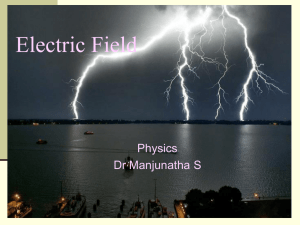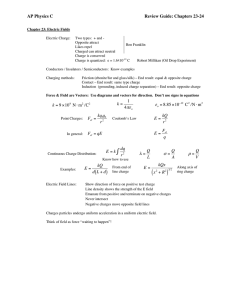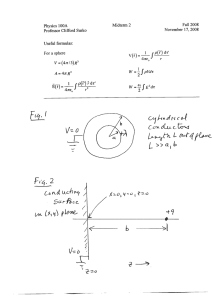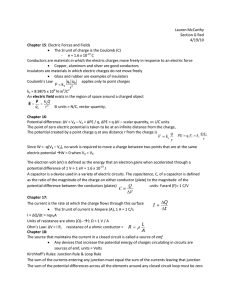Electric Charge and Electric Field: Chapter Summary
advertisement
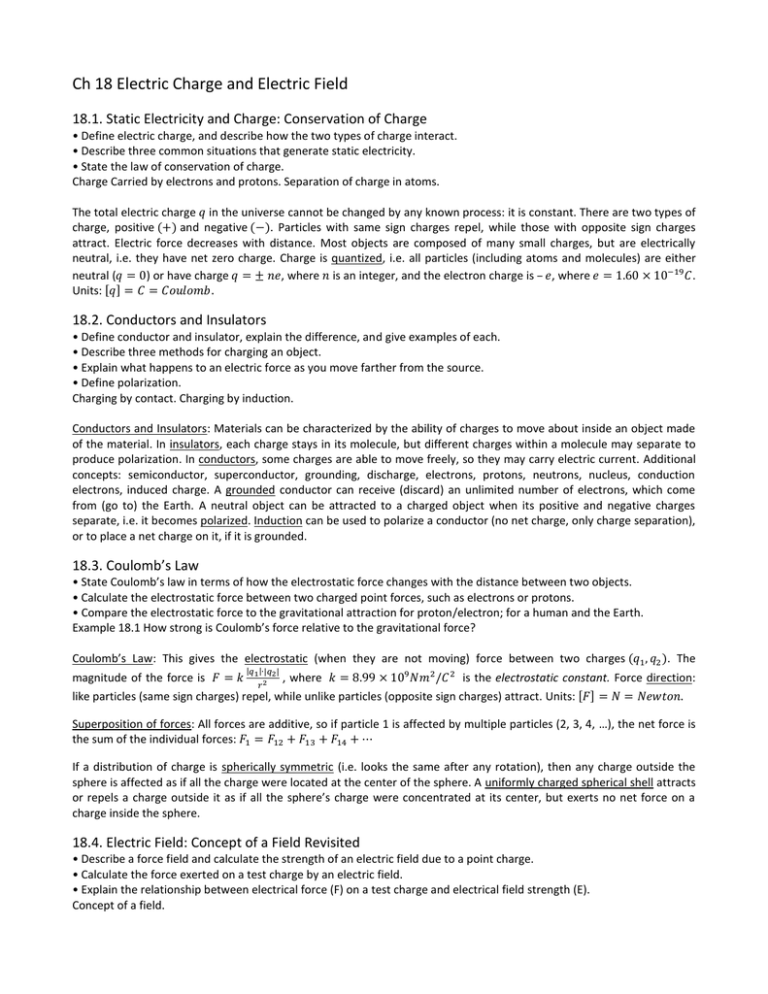
Ch 18 Electric Charge and Electric Field 18.1. Static Electricity and Charge: Conservation of Charge • Define electric charge, and describe how the two types of charge interact. • Describe three common situations that generate static electricity. • State the law of conservation of charge. Charge Carried by electrons and protons. Separation of charge in atoms. The total electric charge in the universe cannot be changed by any known process: it is constant. There are two types of charge, positive and negative . Particles with same sign charges repel, while those with opposite sign charges attract. Electric force decreases with distance. Most objects are composed of many small charges, but are electrically neutral, i.e. they have net zero charge. Charge is quantized, i.e. all particles (including atoms and molecules) are either neutral ( ) or have charge , where is an integer, and the electron charge is – , where . Units: [ ] 18.2. Conductors and Insulators • Define conductor and insulator, explain the difference, and give examples of each. • Describe three methods for charging an object. • Explain what happens to an electric force as you move farther from the source. • Define polarization. Charging by contact. Charging by induction. Conductors and Insulators: Materials can be characterized by the ability of charges to move about inside an object made of the material. In insulators, each charge stays in its molecule, but different charges within a molecule may separate to produce polarization. In conductors, some charges are able to move freely, so they may carry electric current. Additional concepts: semiconductor, superconductor, grounding, discharge, electrons, protons, neutrons, nucleus, conduction electrons, induced charge. A grounded conductor can receive (discard) an unlimited number of electrons, which come from (go to) the Earth. A neutral object can be attracted to a charged object when its positive and negative charges separate, i.e. it becomes polarized. Induction can be used to polarize a conductor (no net charge, only charge separation), or to place a net charge on it, if it is grounded. 18.3. Coulomb’s Law • State Coulomb’s law in terms of how the electrostatic force changes with the distance between two objects. • Calculate the electrostatic force between two charged point forces, such as electrons or protons. • Compare the electrostatic force to the gravitational attraction for proton/electron; for a human and the Earth. Example 18.1 How strong is Coulomb’s force relative to the gravitational force? Coulomb’s Law: This gives the electrostatic (when they are not moving) force between two charges | || . The | magnitude of the force is , where is the electrostatic constant. Force direction: like particles (same sign charges) repel, while unlike particles (opposite sign charges) attract. Units: [ ] Superposition of forces: All forces are additive, so if particle 1 is affected by multiple particles (2, 3, 4, …), the net force is the sum of the individual forces: If a distribution of charge is spherically symmetric (i.e. looks the same after any rotation), then any charge outside the sphere is affected as if all the charge were located at the center of the sphere. A uniformly charged spherical shell attracts or repels a charge outside it as if all the sphere’s charge were concentrated at its center, but exerts no net force on a charge inside the sphere. 18.4. Electric Field: Concept of a Field Revisited • Describe a force field and calculate the strength of an electric field due to a point charge. • Calculate the force exerted on a test charge by an electric field. • Explain the relationship between electrical force (F) on a test charge and electrical field strength (E). Concept of a field. Example 18.2 Calculating the electric field of a point charge. Example 18.3 Calculating the force exerted on a point charge by an electric field. The electric field is the electric force per unit charge at a point in space. If a test particle with charge at a point feels net ⃗ at that point. Units: [ ] electric force ⃗ , then ⃗⃗ The electrostatic force ⃗ acting on a charged particle located in an external electric field ⃗⃗ has the direction of ⃗⃗ if the charge of the particle is positive and has the opposite ⃗⃗ . direction if is negative: ⃗ The electric field of a point charge: The field of a positive (negative) charge points away from (toward) the charge. The | |⁄ magnitude of the field is . Superposition of fields: Fields from different charges are added in the same way as forces. ⃗⃗ ⃗⃗ ⃗⃗ ⃗⃗ 18.5. Electric Field Lines: Multiple Charges • Calculate the total force (magnitude and direction) exerted on a test charge from more than one charge • Describe an electric field diagram of a positive point charge; of a negative point charge with twice the magnitude of positive charge • Draw the electric field lines between two points of the same charge; between two points of opposite charge. Example 18.4 Adding electric fields. Electric field lines: These lines of force enable us to visualize patterns in electric fields. The density of lines in a small region (number crossing a small area, per unit area) is proportional to the magnitude of ⃗⃗ . Additional rules for drawing electric field lines: a) the direction of the tangent to a line at a point gives the direction of ⃗⃗ , b) they start at positive charges or at infinity, c) they end at negative charges or at infinity, and d) the number of lines entering or leaving a charge is proportional to the magnitude of the charge. 18.6. Electric Forces in Biology • Describe how a water molecule is polar. • Explain electrostatic screening by a water molecule within a living cell. Polarity of water molecules. 18.7. Conductors and Electric Fields in Static Equilibrium • List the three properties of a conductor in electrostatic equilibrium. • Explain the effect of an electric field on free charges in a conductor. • Explain why no electric field may exist inside a conductor. • Describe the electric field surrounding Earth. • Explain what happens to an electric field applied to an irregular conductor. • Describe how a lightning rod works. • Explain how a metal car may protect passengers inside from the dangerous electric fields caused by a downed line touching the car. Earth’s electric field. Electric fields on uneven surfaces. Applications of conductors. Behavior of charges and fields within and near a conductor in electrostatic equilibrium: 1) The electric field is zero inside a conductor is zero, 2) Just outside a conductor, the electric field lines are perpendicular to its surface, ending or beginning at charges on the surface, and 3) Any excess charge resides entirely on the surface or surfaces of the conductor. (Note: Excess charge on an isolated spherical conductor will be spread out uniformly over the surface of the conductor.) 18.8. Applications of Electrostatics • Name several real-world applications of the study of electrostatics The Van de Graaff accelerator. Xerography. Laser printers. Ink jet printers and electrostatic painting. Smoke precipitators and electrostatic air cleaning. Integrated concepts. Example 18.5 Acceleration of a charged drop of gasoline. -------------------------------------------------------------------------------------------------------------------------------------------------------- Glossary / Section Summary / Conceptual Questions / Problems and Exercises
